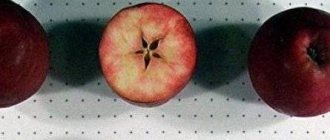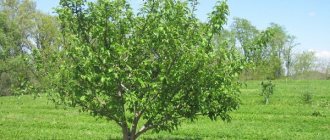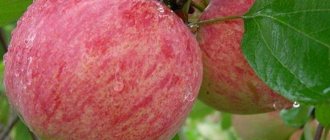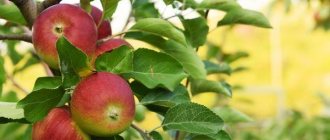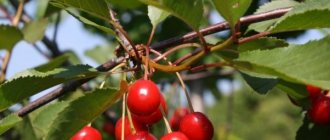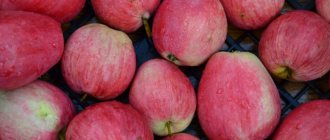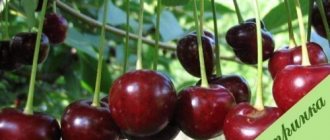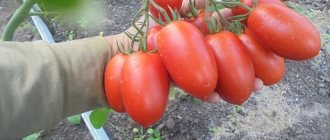Before we begin to describe this subspecies of apple tree, it is worth considering the history of the appearance of this crop. The Cortland apple tree appeared in 1898, thanks to the work of breeding scientists from the New York Experiment Station. The subspecies was bred by crossing varieties such as McIntosh and Ben Davis. In our country, the Cortland apple tree variety became known in the second half of 1915, although by this time it had already gained quite wide popularity in Europe and America. Below we will consider in more detail about this variety of apple tree, as well as all its pros and cons, and the rules of agricultural technology.
Description of the Cortland apple tree
The Cortland apple tree has a rather tall, smooth trunk with brown and brown bark. The crown of the tree has a spreading and voluminous appearance, more reminiscent of a circle. Straight tree shoots of average length, the color of ripe cherry, with slight pubescence.
The leaf blade is short with a distinct tip, covered with veins and grooves. Leaf color is not uniform:
- the upper part is painted in light green tones;
- the lower part of the leaf blade has a more whitish tint.
The flower stalks of the tree are not very large, painted white with a slight shade of pink haze. For the Cortland apple tree, the characteristic features of peduncles are the formation of group inflorescences (from 6 to 9 pieces) in mid-May - early June. The delicate honey aroma of flower stalks attracts a large number of bees.
The first fruits of the Cortland apple tree will have to wait only 6 years after planting the seedling. But, if the seedling was purchased on a medium-sized rootstock MM-106, then the timing of fruiting shifts significantly. It will be possible to get a harvest from such trees 4 years after planting.
From the photo you can make a detailed description of Cortland apples:
The fruits of the Cortland apple tree have a rounded-flattened shape. Based on their appearance and maximum weight of 140 g, they can be classified as medium-sized. The peel of apples is thin and smooth, with a slight bluish waxy coating.
The color of the fruit changes depending on the degree of ripening:
- Green color with slightly visible gray is characteristic of the initial stage of ripening.
- The appearance of a lemon-yellow color with the presence of a waxy coating indicates that the fruits have reached the middle stage of maturity.
- Clear strokes of red shades without a waxy coating appear on a lemon-yellow background - the fruits have reached final ripening.
The stalk is small in size with a large depression. The seeds, which are large and brown in color, are located in wide seed chambers.
The flesh is white in color and has a subtle pink tint to the skin. The structure of the pulp is compacted and very juicy.
additional characteristics
The trees are tall, fast-growing, reaching a height of 5-6 m without pruning. The bark is smooth, brown-brown in color.
The crown is wide-pyramidal, dense, rounded.
The shoots are pubescent, with a dark, almost black tint. The fruits are formed on the ringlets.
The leaves are dark green, the upper part of the leaf blade is shiny, the lower part is gray-green, matte.
The flowers are small, white and pink, collected in inflorescences. The anthers are located above the stigma of the pistil.
The fruits are round, medium in size, weighing 95-130 g. The stalk of a mature fruit remains green. The skin is smooth, during the period of consumer maturity it acquires a crimson-ruddy color with blurred stripes and a bluish waxy coating.
The pulp is sweet-sour, juicy, aromatic.
Taste qualities of Cortland apple variety
The tasting rating of the fruits of the Cortland apple tree is 4.5 points out of 5 possible. Confirmation of this fact can be found in numerous reviews from gardeners who have long and successfully grown the Cortland variety in their garden plots.
Cortland apples have a sweet and sour taste and an unusual fragrant aroma, and are distinguished by their versatility:
- fresh consumption;
- processing into juice, cider, vinegar;
- preparation of dried fruits;
- making jams and marmalade.
Ripening and fruiting Cortland
Beginning of fruiting
Although the tree is not formally considered early-bearing, it begins to bear its first fruits already 5-6 years after planting in open ground. Moreover, the first flowers can be found already in 2-3 years, but they will be lonely and rare, it is better to cut them off immediately. The first harvests are not very abundant; it will hardly be possible to collect up to 5-7 kilograms of fragrant fruits.
Flowering time
Typically, winter apple trees bloom later than earlier types and Cortland is no exception. It blooms its small inflorescences of 6-10 snow-white or white-pink flowers around the middle or end of May. Flowering lasts 10-16 days, depending on the weather. The cooler and rainier it is, the longer this period lasts. The flowers themselves are medium in size, saucer-shaped, fragrant.
Fruiting and growth
The trees grow quite quickly, approximately 25-40 centimeters per year. They reach their maximum pretty soon. In the same way, the variety increases its yields gradually, from small to large. By about 10-15 years you can already collect about 50 kilograms of apples, and by 20 the full maximum. Moreover, in many ways, how much it will be depends on growing conditions, fertilizers and fertilizing, as well as climate and weather.
The fruits are collected around the end of September, but sometimes ripening is delayed until mid-October and even until the very end of the month. They usually don't fall to the ground quickly, so there's no need to worry too much. However, if they lack moisture during the ripening period, they may crumble. The fruits are stored quite well until spring and even until the next harvest, which is why the variety is considered universal.
Top dressing
- Superphosphate.
- Compost.
- Nitrogen fertilizers.
- Humus.
- Potassium complexes.
- Ammonium nitrate.
- Manure.
What to do if it doesn’t bloom or bear fruit
- Check for pests and diseases.
- Replant to a sunnier location.
- Limit or add watering.
Why do apples fall
- Very over-ripe.
- Natural natural factors.
- Pests.
- Diseases.
Leave reviews about the winter-hardy Cortland variety to share your experience with other gardeners.
Previous
Varieties of apple trees Apple tree Bessemyanka Michurinskaya: features of the variety and care
Next
Varieties of apple trees Jeromini apple tree: features of variety and care
Pros and cons of the variety
A description of the Cortland apple tree variety cannot be called complete without indicating its advantages and disadvantages.
The main positive characteristics of the Cortland apple tree:
- regular fruiting;
- high taste qualities;
- long period of storage of fruits without loss of taste;
- versatility of use;
- decorativeness of an adult tree.
The most common disadvantages of this variety are its average winter hardiness and susceptibility to fungal diseases such as powdery mildew and scab.
The appearance of fungal diseases on the apple tree can be avoided by taking timely preventive measures.
Important! It is strictly prohibited to treat trees during the flowering period!
Description, photo
The Cortland apple tree is a winter variety and begins to bear fruit 5-6 years after planting.
Advantages of the variety:
- Regular fruiting
- Long shelf life of fruits,
- Excellent taste of fruits,
- Attractive appearance.
Disadvantages of the variety:
- Moderate winter hardiness,
- Satisfactory resistance to scab and powdery mildew.
Flowering of trees begins in mid-May - early June.
Attention!
Varieties are most suitable as pollinators
Golden Delicious
and Boyken.
Tree productivity is average. The fruits reach ripeness in October and have excellent keeping quality - they are stored in a cool room until the beginning of April.
Tasting score – 4.7 points. The fruits are consumed fresh and in the form of juices.
Cortland apple tree.
Optimal growing conditions
For growing Cortland apple trees, the optimal conditions will be choosing a suitable location on the site and, most importantly, the region of future growth.
The Cortland apple tree has average winter hardiness, so growing it in risky farming regions would be absolutely unacceptable. The Cortland apple tree will grow and develop well in the regions of the Lower Volga region, the Caucasus, the Republic of Crimea and the Donbass. It is possible to plant and grow Cortland apple trees in Belarus and the Baltic countries, but only on standard trees.
Landing rules and technology
In order for an apple tree to please with decent and stable fruiting, it is necessary to follow the basic rules of agricultural technology when planting a seedling. First of all, you need to choose high-quality and healthy planting material. The best option would be to purchase a seedling 1–2 years old. Older plants will take root poorly and bear fruit later.
For planting, it is recommended to give preference to a seedling that has:
- strong, healthy, elastic, without damage, dryness and rot root shoots;
- smooth, elastic and elastic bark of uniform color, without dryness and roughness.
Experts advise purchasing planting material in special nurseries or specialized stores, which guarantees the quality and grade of the apple tree.
Before planting, you need to choose the most comfortable place on the site. It must meet the following requirements:
- spacious, well-lit, sunny place;
- absence of cold winds and drafts;
- the occurrence of groundwater at a depth of at least 2–2.5 m;
- light, nutritious, loose, loamy or sandy loam soil.
Important! If the soil on the site is too “poor”, it is recommended to enrich it with humus, peat and wood ash.
Planting a tree can be done in the spring - before the bud swelling phase, or in the autumn - 3-4 weeks before the expected frost.
The technology of planting seedlings is traditional and consists of several simple steps:
- In the prepared area, dig a hole 70–80 cm deep and up to 1 m in diameter.
- Part of the soil removed from the hole is mixed with 2-3 buckets of humus or peat, half a bucket of river sand, 250 g of superphosphate and 300 g of wood ash.
- The bottom of the recess is lined with a drainage layer of expanded clay or broken brick.
- A portion of fertile soil is poured on top of the drainage layer, from which a small mound is made.
- A wooden peg is inserted into the earthen mound, which will serve as a support for the seedling.
- The plant is placed on the mound and the root shoots are carefully leveled.
- The seedling is sprinkled with earth, while the root collar is left on the surface, at a level of 5–8 cm from the ground.
- The plant is watered abundantly with 2-3 buckets of settled warm water, the soil around the tree trunk is mulched with sawdust, hay or mown grass.
- The seedling is tied to a support.
Important! When planting several seedlings at once, the interval between them should be at least 5 m.
Planting and caring for a Cortland apple tree
Proper agricultural technology and proper care of the Cortland apple tree will allow you to obtain a harvest of ripe and juicy apples.
This calendar will help gardeners create the best care for seedlings and mature Cortland apple trees.
Selection and preparation of a landing site
The issue of choosing and preparing a site for planting a Cortland apple tree must be approached thoroughly.
The apple tree prefers sunny areas with fertile, breathable, loamy or sandy soil. The moisture capacity of the soil is also an important criterion, but prolonged stagnation of melt water or the location of underground ground rivers closer than 2 m to the surface can lead to the death of the tree.
If the planting site is dominated by depleted or heavy soils, then it will be necessary to carry out additional work to enrich the soil by preparing a nutrient substrate. To prepare it you will need:
- the top fertile layer of soil dug out from the future planting hole;
- sand;
- humus or high peat;
- superphosphate (0.25 kg);
- wood ash (0.3 kg).
All components must be thoroughly mixed, after which the resulting nutrient substrate can be used to plant a Cortland apple tree seedling.
Preparation of the selected area must be carried out in advance. Several months before the planned planting, a number of preparatory works are carried out:
- Digging the soil.
- Loosening.
- Removal of weeds.
- Fertilizer application.
After all the steps have been completed, the soil must be dug up again, after which the planting hole is prepared.
Important! When planting seedlings in spring, it is better to dig a hole in the fall.
If it was not possible to prepare it in the fall, then the planting hole is prepared 2 weeks before the planned planting.
Seedling preparation
Before you begin preparing a seedling, you must purchase it. The best choice would be to buy one- or two-year-old Cortland apple tree seedlings.
Important! It is best to purchase seedlings from certified fruit nurseries; this will reduce the risk of purchasing a diseased or weak bush.
Before planting a seedling, it is necessary to carefully inspect the root system. If there are damaged skeletal roots, they will need to be pruned. If the root system has overly branched roots, they will need to be trimmed by 15 cm.
For better contact with the soil, the roots must be dipped into the mash solution. It is prepared in equal parts from clay and mullein. This treatment of the root system will significantly speed up the survival time of the Cortland apple tree seedling.
Landing rules
Cortland apple trees are planted in early spring or autumn. But many years of experience of gardeners and agronomists shows that better development can only be achieved by planting a Cortland apple tree seedling in the spring.
When planting, it is necessary to take into account the structure and fertility of the soil.
| Soil type | Planting hole size (cm) | Adding nutrient substrate | Reduced filtration |
| Fertile | 70x70x70 | — | — |
| Heavy clay | 100x100x100 | Necessary | — |
| Sandy | 100x100x100 | Necessary | The bottom is covered with clay to a depth of 15 cm. |
If you plan to plant several seedlings, then there should be a distance of up to 5 m between them. The Cortland apple tree can grow and develop for at least 70 years, which is why the distance between seedlings is so important.
The technology for properly planting a seedling includes the following steps:
- Preparing the planting hole.
- Adding nutrient substrate in the amount of 1/3 of the total volume of the planting pit.
- Digging in the support trunk.
- Vertical placement of the seedling in the hole with mandatory leveling of the root system.
- Filling the top layer of soil.
- Compacting the planting.
- Charging watering in the amount of 3 buckets of water per seedling.
- Mulching the tree trunk circle.
Important! If the grafting site is located 5-7 cm above the ground level, then the seedling was planted correctly.
Watering and fertilizing
During the first years of the growing season, an apple tree seedling must be watered every 2 weeks, and in the event of a dry summer, when starting to prepare the tree for winter, it is necessary to carry out water-recharging watering in September. To do this, you need to pour 30 liters of water into the tree trunk circle for each year of plant development, for example, if 3 years have passed since planting, then you will need 90 liters of water per tree.
The amount of fertilizer required for better development of a tree in different years of life is indicated in more detail in the table.
| One year after landing | Diameter of the trunk circle (m) | Manure or compost (kg) | Urea (kg) | Superphosphate (kg) | Potassium sulfate (kg) |
| 1-2 | 2 | 15-20 | 0,03 | 0,12 | 0,04 |
| 3-4 | 2,5 | 20-25 | 0,045 | 0,18 | 0,06 |
| 5-6 | 3 | 30-40 | 0,065 | 0,27 | 0,09 |
| 7-8 | 3,5 | 40-50 | 0,09 | 0,36 | 0,12 |
| 9-10 | 4 | 40-50 | 0,14 | 0,48 | 0,15 |
| 11-12 | 5 | 80 | 0,18 | 0,75 | 0,24 |
When the tree is over 13 years old, fertilization will correspond to the bottom line of the table.
Trimming
The Cortland apple tree requires pruning, which should be done every year. This must be done not only in old trees, but also in young ones.
There are 4 types of tree pruning:
- Formative. This pruning is carried out on 5-year-old trees in order to form a crown of the correct shape and increase its illumination.
- Sanitary. Trimming damaged and improperly growing branches.
- Regulatory. It inhibits the tree's upward growth and deprives the crown of shading branches.
- Rejuvenating. Old apple trees need this type of pruning. It will increase the yield.
The photo clearly demonstrates the rules for pruning the Cortland apple tree in different years of the growing season:
Another, but very important factor is that when carrying out any type of apple tree pruning, the air temperature should become stable, and the thermometer should not fall below + 10 °C.
Preparing for winter
In order for the apple tree to successfully overwinter, it is necessary to prepare the tree for wintering already at the end of September or at the beginning of October.
A dry mixture of superphosphate and potassium should be added to the tree trunk circle. For 1 m2 you will need 30 g of potassium and 50 g of superphosphate. The mixture is scattered a little further from the tree trunk, then the soil must be dug up onto the bayonet of a shovel. After this, water-charging irrigation is carried out.
While the leaves have not fallen, it is necessary to treat the trees with urea. To prepare the solution, you will need to dilute 0.5 kg of fertilizer in a bucket of water. Wood treatment is carried out by leaf spraying. This will reduce the risk of fungal diseases and the likelihood of spider mites appearing in the spring.
Do not forget about whitewashing trees, as it protects the bark of the apple tree from sudden changes in temperature, bright sun, cold wind and frost. Whitewashing can also protect the bark from attacks by insect pests and from the teeth of mice and hares.
For whitewashing, you can dilute 400 g of lime and 100 g of copper sulfate in 10 liters of water. The surface of the apple tree trunk is carefully treated with the resulting solution.
Features of growing Cortland
Landing
Basic conditions
- For planting the variety, choose only a well-ventilated and sunny place. It is best that there is no shadow or it is insignificant. The place should not be exposed to drafts, as this will cause the seedlings to become sick and grow weak.
- It is not the best choice to plant Cortland near any body of water, be it a lake, river, pond or shallow well. The occurrence of groundwater should be at least 2.5-3 meters deep. In another case, trees are drawn to water by their roots, which subsequently begin to rot and can destroy the entire tree.
- The pits for the variety are prepared in advance, preferably in the fall or spring, but it is also possible 3-4 weeks in advance. To do this, dig a hole 75-85 centimeters deep and one meter in diameter, pour soil mixed with any available fertilizer onto its bottom, lay a drainage layer of gravel or crushed brick, and then fill it with 35-55 liters of water. All this must be left in the open air, without covering.
- It is best to leave at least 4.5-5 meters between rows and the same between plants in rows. At the same time, you will have to remember about timely pruning. If the trees grow excessively, they will interfere with each other, which will negatively affect the harvest.
- It is advisable to immediately drive supporting stakes into the holes, which can be made not only from metal or wood, but also from plastic.
- The root system of the seedling is inspected a day before planting, any dry, broken or diseased shoots are cut off using garden pruners and soaked in warm water.
- When planting, the root collar of the tree must rise above the surface by at least 6-11 centimeters. Otherwise, it will take root higher, then all the properties and qualities of the rootstock will be lost.
- The seedling is placed directly on the drainage pile, the roots are straightened with your hands, sprinkled with soil, lightly tamping it in layers so that it holds tightly and does not fall, and tied to a support. The near-trunk circle is surrounded by a small earthen rampart around the perimeter, into which 20-45 liters of water are poured. The surface is mulched with any suitable material.
Disembarkation dates
In a suitable climate, trees can be planted not only in spring, when frosts will not return (late March or early April). They also take root well during autumn planting at the end of September or beginning of October. The main thing is that there are at least 4-6 weeks left before the first frost, otherwise the trees may be seriously damaged and will not recover.
Protection from frost and rodents
The cooler the climate and weather of a particular year, the more efficiently the trees need to be protected from frost. You can rake soil (20-25 centimeters) onto the roots near the trunk, or lay special mats of dry grass or straw sheaves, so the rhizomes will not freeze. It is good to wrap dwarf trees with burlap using the tent method, but this will not work with tall specimens. Therefore, it will be enough to wrap the trunks with roofing felt, agrofibre, or roofing felt.
To prevent rodents from eating young twigs and bark, the trunks are smeared with a thick layer of pork lard or any other rendered fat of animal origin. But you can purchase special industrial products, they work even better. Whitewashing helps against insects in spring and autumn.
Tree care
Loosening the soil, watering: proper agricultural technology
The trunk area of Cortland needs to be dug up twice a year, in spring and autumn. This way you will also remove weeds, shoots of various other plants, and root shoots. In between, you can hoe the soil to increase oxygen access to the roots. This is not necessary, but it is advisable.
In warm weather, trees will have to be watered regularly; without the proper amount of moisture, the trees will not be able to cope with the ripening of the crop, and it may fall to the ground. It is best to do about 6-10 waterings per growing season, applying 15-25 liters of water per adult tree twice (morning and evening).
Pruning: simple crown formation
In the first years, you can cut off the central conductor by one third and leave 2-3 skeletal branches far from each other. However, full formation is carried out only at about the 5th year, so as not to seriously injure the young seedling. You can form any crown you like. The tree is not prone to particularly thickening, so there should not be any special problems with further adjustments to the shape.
Sanitary pruning, when dry shoots, diseased or damaged branches are removed, is done in late autumn or early spring. All cut areas must be covered with garden varnish. If you don’t have one at hand, you can paint over the wound with water-based paint or even millet with an ordinary mash of water and earth (swamp).
Pollinator varieties
- Delicious golden.
- Spartan.
- Welsey.
- Mantet.
- Antonovka.
- Boyken.
Reproduction
- Rooting cuttings.
- Grafting with buds and cuttings.
- Growing from seeds.
- Clones (layers).
Diseases and pests
- Powdery mildew.
- Cytosporosis.
- Fruit rot.
- Scab.
- Cytosporosis.
- Tinder fungus.
- Green aphid.
- Codling moth.
Diseases and pests
With all the advantages of the Cortland apple tree, it cannot boast of 100% resistance to fungal infections and attacks by insect pests. Most often, the Cortland apple tree variety is affected by scab and powdery mildew.
To prevent the appearance of scab, it is necessary to perform a number of measures:
- Application of potassium-phosphorus fertilizers.
- Autumn cleaning of carrion and leaves.
- Autumn processing of bark by stripping and whitewashing.
- Autumn treatment with solutions of copper sulfate and urea.
- Spring treatment with Bordeaux mixture.
To prevent and treat apple trees from powdery mildew, the gardener needs to treat with fungicide solutions during the periods before and after flowering:
- Bordeaux mixture;
- chorus;
- speed
You can fight insect pests using acaricidal drugs:
- Aktara;
- Talstar;
- Inta-Vir;
- Karbofos;
- Kinmiks.
Treatment with any preparations should be carried out in dry, windless weather in the morning or evening, observing all safety measures when working.
Tree diseases
The Cortland variety is not highly resistant to scab, therefore, to prevent infection with fungal diseases, it is recommended to carry out regular preventive measures:
- fertilizing the tree with potassium-phosphorus mixtures;
- mandatory autumn garbage collection (fallen leaves, branches);
- spring whitewashing of the trunk and skeletal branches;
- spraying the apple tree with copper sulfate in the fall and Bordeaux mixture in the spring.
It would be appropriate to say about the Cortland variety that with proper care, the apple tree will delight you with a tasty harvest for decades.
Reviews of the Cortland apple tree
Vilkova Anastasia Olegovna, 38 years old, Lugansk
The Cortland apple tree was planted 12 years ago, and when purchasing a seedling, the seller simply persuaded us to take this particular variety. For several years in a row, my husband and I had thoughts of simply cutting down a tree. Only in the 3rd year of its life the tree gave us 2 apples. But what a surprise we were when there were more fruits on the tree, and the taste of apples was difficult to replace with some other variety. 8 years after planting, the tree began to bear fruit annually and consistently. If gardeners still want to buy a new variety of apple tree, then I definitely recommend purchasing Cortland. The only thing you need to do is be patient, and the result will exceed all expectations.
Karpukhin Mikhail Vladimirovich, 46 years old, Volgograd
My summer cottage is located in close proximity to the river and any variety of apple trees that I planted died after 4 years. A friend recommended the Cortland variety. To my surprise, this particular variety turned out to be the most durable on my site. Trying the first fruits of the apple tree caused me simply indescribable delight - the sweet and sour taste and extraordinary aroma simply made me fall in love with this apple tree. And when the price of fruit is high in winter, I have no need to purchase market apples - mine are perfectly stored in the basement until April. I recommend this variety to gardeners, because, in my opinion, it is quite promising, and tree care is minimal.
Reviews
Anastasia. “We have been growing this variety of apple tree for 10 years, it tolerates winter well, we harvest it every year. The apples are very tasty and juicy. We store them in our basement until spring, they don’t fade and the taste doesn’t change. We also want to plant this variety grafted onto a dwarf rootstock. They say that then the apples taste even better.”
Alexander. “I have a dacha not far from the river, so all the trees die within 4-5 years, apparently reaching the water level. I was recommended the dwarf variety Cortland. I looked at the photo and description of the variety and bought it. The tree has grown small, now about 2.5 m. The harvest was 2 apples in the third year. But how delicious these apples are! I recommend it to all gardeners."
Michael. “This is my favorite variety. Apples have a sweet and sour taste, they are very juicy and crunchy. The juice comes out excellent, and the apples last until spring. I regularly care for the trees: I feed them, trim them, spray them. Then the apple tree will definitely reward you with a bountiful harvest.”
Description of the variety
This is a late autumn variety that is easy to care for and boasts excellent frost resistance. Ripe fruits are large in size, and they are rich in a variety of microelements and vitamins.
Thanks to its unpretentiousness, this apple tree grows easily in northern climates and is able to bear fruit even in rainy, cloudy summers. Like most fall varieties, Granny Smith is harvested in September–October.
At the same time, in a cool climate, later ripening of the crop is possible. This variety is fast-growing and bears fruit regularly. The tree can bear fruit for 10 years, with peak yield occurring 5-7 years after planting the tree.
Trees of the Granny Smith variety are medium-sized and are considered semi-dwarf with a spreading crown. A distinctive feature of this variety is the large size of the apples, the weight of which can be about 300 grams. Ripe fruits have a rich green color with pronounced white subcutaneous dots.
When the tree is provided with appropriate care, the fruits stay firmly on the stalk and do not fall to the ground. This greatly simplifies harvesting, and the gardener is freed from the danger of rotting apples that fall to the ground. The pulp of ripened fruits has a juicy sweet and sour taste.
This variety gained its popularity due to the minimal calorie content of apples. This allows you to include this fruit in various diets for weight loss. Moreover, apples are completely hypoallergenic and can be included in the diet of young children. They contain numerous vitamins beneficial to the body and help solve problems with vitamin deficiency and are recommended when the body is weakened.
This variety is a medium-yielding variety, and allows you to get the first fruits already in the second year after planting. In the fifth year, the gardener will be able to collect about 15 kilograms of delicious apples from one tree. When choosing this variety, you should remember that Granny Smith is an excellent pollinator for various self-fertile varieties of apples.
Ripening and fruiting
The first fruits are harvested from the apple tree after 5 years. But full fruiting begins at the 8th year of life. The collection takes place in September. It is better to do this in dry weather to preserve the fruits as long as possible.
Fruits of the Cortland apple tree.
Apples that are collected from the tree must be carefully placed in boxes. Each layer is covered with straw or sawdust. The place in which the apples are placed should be quite cold, about 0°C, with high air humidity and good ventilation.
If all these conditions are met, storage can last until the beginning of spring. At the same time, all the commercial and taste characteristics of the fruit are preserved.
Description of the Cortland apple tree variety and its characteristics, breeding history and yield
Growing Cortland apple trees is popular among domestic gardeners. This variety attracts them with its taste and the ability of the fruit to be stored for a long time. The tree itself, due to its compactness, is well suited for growing in summer cottages. But, like any variety, Cortland has its own growing characteristics that must be taken into account if there are prospects for a good harvest.
History of variety development
The variety was bred by American breeders in 1898. To obtain it, employees of the New York Experimental Breeding Station crossed two popular varieties at that time - McIntosh and Ben Davis. Cortland gained worldwide fame after the First World War.
Description and features
To describe this variety, first of all, you should pay attention to two characteristics - the size of the tree and the characteristics of the fruit. This apple tree is classified as both medium-sized and medium-yielding. The fruits are medium in size, but have a pleasant taste and beautiful appearance.
What are the pros and cons of the variety?
The Cortland apple tree can boast of advantages that force many domestic gardeners to give preference to it:
- its fruits are stored for a long time;
- have a pronounced taste;
- attractive appearance;
- The plant is compact with a dense crown.
At the same time, one cannot help but note a number of shortcomings that make some summer residents think about starting this variety:
- average resistance to scab;
- low resistance to powdery mildew;
- average yield.
Those who are interested in yield indicators should pay attention to these features.
Main characteristics of the Cortland apple tree
The Cortland apple tree has a number of characteristics that distinguish it from other famous varieties. They concern both the tree itself and the fruit.
Cortland apple trees have an average height that does not exceed six meters. Their crown is wide, with a somewhat pronounced pyramidality.
Trees are strong. The gray-burgundy bark on the trunk has no roughness and is smooth. A distinctive feature of the shoots is a significant number of small lentils. In addition, they have a burgundy color and a lowered shape. They rarely take any form other than straight.
The edges of the leaves are large-shaped. And their plates are flat. In general, the foliage is dense. At the same time, the underside of the leaf is matte, gray-green, and the upper side is shiny and bright. Fruit development occurs on their ringlets.
Fruit evaluation
Apples of this variety do not differ in size and significant weight - up to 130 grams. The shape of the fruit is somewhat elongated and streamlined. The skin is soft and thin.
The color of unripe fruits is greenish-yellow with barely noticeable stripes of red. The haze is clearly visible. As they ripen, they become redder. Another distinctive feature of apples is a bluish coating.
But these are not the only features of the fruits of the Cortland variety. Also noted:
- significant size of the stalk recess, shaped like a cone;
- small cup size, which is either slightly open or completely closed;
- the upper pit of the fruit is small;
- free and wide seed chambers;
- pulp with a whitish tint and redness around the edges;
- rich aroma.
The peduncle of this variety is small in size and green in color, which turns yellow when the apples are ripe.
Winter hardiness
Cortland is a winter-hardy variety. Bred in North America and can withstand extremely low temperatures. Thanks to this, it is suitable for cultivation in most regions of Russia, even with the harshest climate.
Disease resistance
Exceptional resistance to diseases and pests is one of the reasons why Cortland apple trees are so popular. But this does not mean that they are not affected by them in principle. Unfortunately, there are two diseases from which these plants can still suffer, under certain unfavorable conditions:
The main symptom of powdery mildew is a gray-white coating on the leaves. Over time, the foliage that is affected by the disease turns brown and falls off. Plaque also appears on shoots. Later they lose their shape and die.
The disease does not bypass the inflorescences, as well as the fruits. The symptoms are the same as when shoots are affected. A rust-colored net forms on the fruit.
The main condition for the development (either powdery mildew or scab) is called cool summer nights combined with high humidity. The fall of morning dew drops plays a role.
Frequency of fruiting
The variety is one of those that begins to bear fruit quickly. If it is grafted onto a dwarf rootstock, the first harvest is obtained already in the third year.
The tree blooms from about mid-May. In the Middle Zone, during a cool spring, the beginning of the process is delayed until the beginning of June. According to the time of fruit ripening, it is classified as pre-winter - the fruits are harvested in mid-October.
Fruiting is equally regular in grafted apple trees and those grown from seedlings. The latter, by the way, begin to produce crops in the sixth year. The overall yield is average.
Productivity
This variety of apples has an average yield, which, under favorable conditions, becomes high. At the same time, it bears fruit regularly. Lean years are rare for him.
Regions of distribution
This variety is widespread in almost all regions of Russia, except the Far North. Often found in the Volgograd and Saratov regions, where conditions for the growth of apples are suitable.
Conclusion
The Cortland apple tree is loved for many things - for its pleasant taste and beautiful appearance, for its durability and ability to survive various climatic conditions. Does not require constant care when growing.
The main thing is to prevent scab and powdery mildew infections. To do this, you should avoid wet places and use preventive medications in humid, cool years.
Source: //DachaMechty.ru/yablonya/kortland.html

